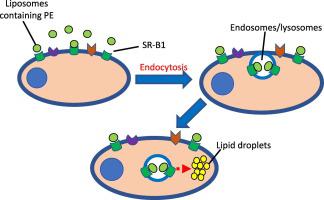Biochimica et Biophysica Acta (BBA) - Molecular Cell Research ( IF 5.1 ) Pub Date : 2020-09-18 , DOI: 10.1016/j.bbamcr.2020.118859 Kazuyo Fujita 1 , Narumi Koide 2 , Masaharu Somiya 3 , Shun'ichi Kuroda 4 , Shuji Hinuma 3

|
We have recently reported that phosphatidylethanolamine (PE)-containing liposomes are endocytosed and then induce lipid droplets (LDs) in HEK293T cells. In this study, we elucidated a mechanism responsible for endocytosis of PE-containing liposomes and induction of LDs. By using fluorescence-labeled liposomes and flow cytometry, we found that PE-containing liposomes were very efficiently internalized in HEK293T cells. However, Block lipid transporter-1 (BLT-1) only marginally suppressed the uptake of these liposomes, indicating that entire liposomes were mostly taken up in these cells. They were therefore inferred to express abundant PE receptors responsible for endocytosis of PE-containing liposomes. We examined the expression of 52 candidate genes through transcriptomic analyses and eventually narrowed it down to four candidate genes, which were abundantly expressed in HEK293T cells. Among siRNAs targeting these candidates, scavenger receptor class B type 1 (SR-B1) siRNA showed the most profound reduction in PE liposomal uptake. Conversely, the expression of SR-B1 by transfection of an expression plasmid enhanced the uptake of PE-containing liposomes. After the internalization of PE-containing liposomes, they were colocalized with endosomes/lysosomes and SR-B1, which indicates that these liposomes are taken up in HEK293T cells at least partially through the endosomal/lysosomal pathway. A specific anti-SR-B1-antibody blocked the uptake of PE-containing liposomes in HEK293T cells while LD formation in these cells induced by PE-containing liposomes was suppressed by treatment with SR-B1 siRNA. These results demonstrate that SR-B1 functions as a receptor for the endocytosis of PE-containing liposomes and regulates the formation of LDs induced by PE-containing liposomes in HEK293T cells.
中文翻译:

B型清道夫受体在HEK293T细胞中由含磷脂酰乙醇胺的脂质体诱导的内吞作用和脂质滴形成中的调节作用。
最近,我们报道了含磷脂酰乙醇胺(PE)的脂质体被内吞,然后在HEK293T细胞中诱导了脂质滴(LDs)。在这项研究中,我们阐明了负责含PE脂质体的内吞作用和LDs诱导的机制。通过使用荧光标记的脂质体和流式细胞仪,我们发现含PE的脂质体在HEK293T细胞中非常有效地内化。但是,Block脂质转运蛋白1(BLT-1)仅略微抑制了这些脂质体的摄取,表明整个脂质体大部分被这些细胞吸收。因此,可以推断出它们表达了丰富的PE受体,这些受体负责内含PE脂质体的内吞作用。我们通过转录组分析检查了52个候选基因的表达,并最终将其缩小为四个候选基因,在HEK293T细胞中大量表达。在靶向这些候选物的siRNA中,B类清道夫受体1型(SR-B1)siRNA表现出PE脂质体摄取的最大程度降低。相反地,通过转染表达质粒来表达SR-B1增强了含PE脂质体的摄取。内含PE的脂质体内化后,它们与内体/溶酶体和SR-B1共定位,这表明这些脂质体至少部分通过内体/溶酶体途径吸收在HEK293T细胞中。特定的抗SR-B1抗体阻断了HEK293T细胞中含PE脂质体的摄取,而这些含PE脂质体诱导的细胞中LD的形成则通过SR-B1 siRNA处理得以抑制。



























 京公网安备 11010802027423号
京公网安备 11010802027423号